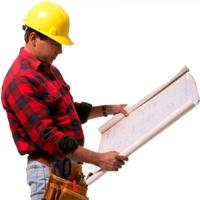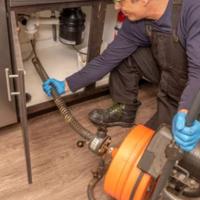Should You Opt for Trenchless Sewer Repair?
by Joe Goldstein on Aug 6, 2019
Dealing with sewer problems isn’t a ton of fun. At best you might have a bad smell coming up through your drains, or a tree growing into your pipes. At worst you might have a backed-up sewer or a fine from the city.
Whatever your problem is, trenchless sewer repair offers an alternative to standard sewer repair that has the potential to save you time, money, and a lot of headaches.
But trenchless sewer repair isn’t right for every household or situation.
What is Trenchless Sewer Repair?
Trenchless sewer repair is a technique for repairing (or replacing) your sewer lateral without digging a full trench. A plumber will dig an access hole at either end of your sewer lateral, feed in a purpose-built machine, and install the new pipe inside your old one. This installation process can either cover your old pipe from the inside (pipe relining) or destroy it and replace it with a larger pipe (pipe bursting.)
While trenchless sewer repair has quickly become the norm in some parts of the U.S., it still has a long way to go.
Trenchless Wins in Most Categories
Let’s cut right to the chase: trenchless makes sense for the majority of situations. Here are a few highlights.
- Trenchless is faster. While trenched sewer repair jobs often take several days to a week, a trenchless sewer repair can often be completed in an afternoon or two.
- Trenchless is usually cheaper. The biggest cost involved with sewer repair is labor, not parts. If you don’t need four extra plumbers on site to tear up your lawn, that’s money in your pocket.
- Trenchless damages your yard less. Trenchless sewer repair doesn’t require you to extensively tear up your trees, gardening, and lawns. It just requires those two access points.
- Trenchless lasts longer. The cured-in-place pipes used with trenchless repairs are designed to last up to 50 years, so you won’t have to sacrifice quality for convenience.
When Does Trenchless Not Make Sense?
Trenchless sewer repair seems like an easy choice, but there are always exceptions. Here are some of the reasons you might want to (or need to) go with trenched repair instead.
- Is it a short lateral? If the distance from your home to the curb is short, the trench could be too, which means there isn’t as big of an advantage to going trenchless. However, different cities have different regulations when it comes to the cutoff line for homeowner responsibility. For example, some homeowners are responsible for their sewer line up to the property line cleanout, while others are responsible all the way to the mainline.
- Are tree roots the problem? Root invasion is a serious problem for sewer pipes. Tree roots commonly seek out sources of water, because that’s what the trees need. While replacing your sewer line with a trenchless one can delay that growth, there are other ways to keep roots out of your sewer lateral.
- Is the slope intact? Sewer laterals rely on gravity to keep things moving. If your sewer line no longer slopes gently downwards, maybe thanks to an earthquake or construction damage, your new trenchless sewer line won’t work much better than your old one. You’ll need to let a plumber manually reseat the line.
- Can you find a good specialist? Trenchless sewer repair is still a specialty service, so every plumber isn’t going to have the skills or equipment to offer it. You’re better off hiring a good contractor to perform a trenched repair than a bad one to perform a trenchless.
No Solution is Perfect
While trenchless sewer repair is a big step forward from trenched repair, no solution is without its drawbacks. Be sure you know the real pros and cons before deciding on trenchless, and don’t be afraid to ask around for second opinions before spending that kind of money.
Popular Articles
Three Places to Spend Money on the Exterior of Your Home
When you have the exterior of your home remodeled, you are investing, time, energy and convenience into the project and you want to make sure that...
104844 Views
Homemade Headboards-Make an Upholstered or Wooden Headboard
Homemade headboards can add a lot of personality to any bedroom. They can be coordinated with existing furniture and room decor or they can be the...
80113 Views
When to Use a Brush, Roller or Sponge Brush
Brushes are a good choice for painting trim and woodwork. They are also useful for cutting in the edges around the top and bottom edges and corners...
72773 Views
Creating a Cottage Kitchen with Bead Board
Kitchen decor can range from modern and bold to elegant and elaborate by using strategic kitchen pieces. One of the most popular decorating trends...
58539 Views
Gas Fireplace Diagnostics and Troubleshooting
Follow these steps for diagnosing and troubleshooting Gas Fireplaces repairs. For the average DIYer, this may seem intimidating, depending on the...
35578 Views
Latest Articles
How Much Does it Cost to Take a Bath?
Plumbers know that a bath may seem like a relaxing luxury, but the real cost extends far beyond your water bill. The average soak uses 35 to 50...
on Apr 8, 2025
10 Concrete Patio Ideas on a Budget
A concrete patio can be a game-changer for your outdoor space. It is durable, versatile, and can be customized to fit your style. But what if you...
on Mar 25, 2025
Tips for Creating a Stunning Personalized Photo on Canvas
Order the unique beauty of a personalized photo on canvas and bring your memories to life. With a customized photo on canvas, you can transform...
on Mar 7, 2025
Best Areas to Buy Property in Singapore for Long-Term Growth
Singapore's real estate market remains one of the most stable and lucrative in the world. With limited land supply, strong governmental...
on Feb 18, 2025
Troubleshooting Excess Water in Your HVAC Secondary Condensate Drain Pan
When maintaining your air conditioning system, it is easy to overlook the condensate drain pan - until excess water starts pooling in places where...
on Jan 12, 2025
Featured Articles
What Type of Licensed Contractor Should You Hire?
on Feb 28, 2017
Hire Contractors / Estimates

Looking for a specialty project? There are many types of contractors available for your home improvement needs. Finding the right type of...
Sponsored Articles
Best Areas to Buy Property in Singapore for Long-Term Growth
on Feb 18, 2025
Real Estate / Finance

Singapore's real estate market remains one of the most stable and lucrative in the world. With limited land supply, strong governmental...
Actions
Top Categories
- Garden / Landscaping / Patio — 264
- Kitchen / Bathrooms — 240
- Real Estate / Finance — 203
- Appliance / Repair — 186
- Interior Design / Decor — 184
- HVAC / Air Conditioning — 148
- Cleaning / Maintenance — 144
- Improvements / Remodeling — 131
- Plumbing / Basements — 118
- Floors / Tile / Hardwood — 116
- Doors / Garages — 113
- Safety / Security — 113
Articles Archive
More DIY Articles
What to Know When Choosing an Air Conditioner
You cannot blame yourself when you are currently shopping for a new aircon that you would be able to use for your home. You would want to use an...
Woodchucks/Groundhog Prevention
Groundhog day may have passed unnoticed for some, but for homeowners and gardeners groundhog season is only just beginning. Groundhogs (woodchucks)...
Practical Advice for Taking Care of some Common Kitchen Appliances
Like any other piece of equipment, kitchen appliances last longer if they are maintained in good condition with regular care. Cleaning is essential...
4 Reasons You Should Call a Plumber to Fix Your Plumbing
Over time, virtually every house develops a minor plumbing problem that needs some repair. Early on, it might not seem like a big deal, so most...
Learn Them All in Minutes: Six Essential Wiring Skills
Take a few minutes to review the essential wiring skills shown on the following pages. Many have helpful animations that show you exactly what...

